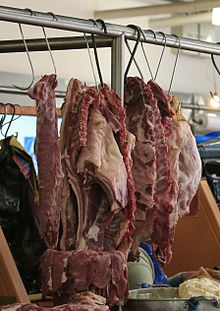Meat hook
A meat hook (also meat hook or butcher hook ) is a hook for hanging and transporting meat and sausage , which is often used in slaughterhouses and butchers / butchers / slaughterhouses. It consists of a metal rod several millimeters thick that is curved (double) arched. At least one end is sanded on three or four sides so that the meat can be held without unnecessary damage.
In Germany, meat hooks in accordance with DIN 250 are common. These are standardized, S-shaped hooks with a pointed end for piercing pieces of meat and a blunt end as protection for the worker. They are usually made of stainless steel . The load capacity depends on the size and rod thickness and is around 15 kg to 90 kg or more per piece. There are also S-shaped meat hooks that are designed as swivel hooks with a central ball joint and have a load capacity of up to about 180 kg.
variants
There are different variants of the S-shaped meat hook, such as:
- Bacon (side) hooks: Contains two to five hook points lying next to each other, with rear or side suspension. It is used to hang up and transport pages of bacon .
- Fixed meat hooks: One-sided rigid hooks, usually in the form of hook strips. In addition to meat processing, they are often used in the sales counter area of butchers / butchers / slaughterhouses.
- Handle hook: One-sided hook with a handle made of plastic or aluminum (formerly also made of wood) at the "blunt" end - often designed to be transverse. It is one of the professional tools of butchers / butchers / butchers and is used to lift and transport heavy pieces of meat.
history
Meat hooks were used for ceremonial purposes in prehistoric times, such as the meat hooks from Dunaverney or meat hooks from Little Thetford .
In executions by hanging the noose on free-hanging hook attached and strangled the victim without his neck was broken by a fall immediately. Meat hooks were used on December 15, 1942 for the execution of members of the Rote Kapelle as well as on August 8, 1944 for those involved in the assassination attempt of July 20, 1944 on Hitler's orders , in order to use this particularly dishonorable and agonizing form of execution.
Web links
Individual evidence
- ↑ Henriette Schuppener: “Nothing was free”: Harald Poelchau and the German Resistance, Lit Verlag, 2006, ISBN 978-3825893156 , p. 82 ( limited preview in the Google book search).
- ↑ David Clay Large: Berlin: Biographie einer Stadt, CH Beck, 2002, ISBN 3406488811 , p. 333 ( limited preview in Google book search).


